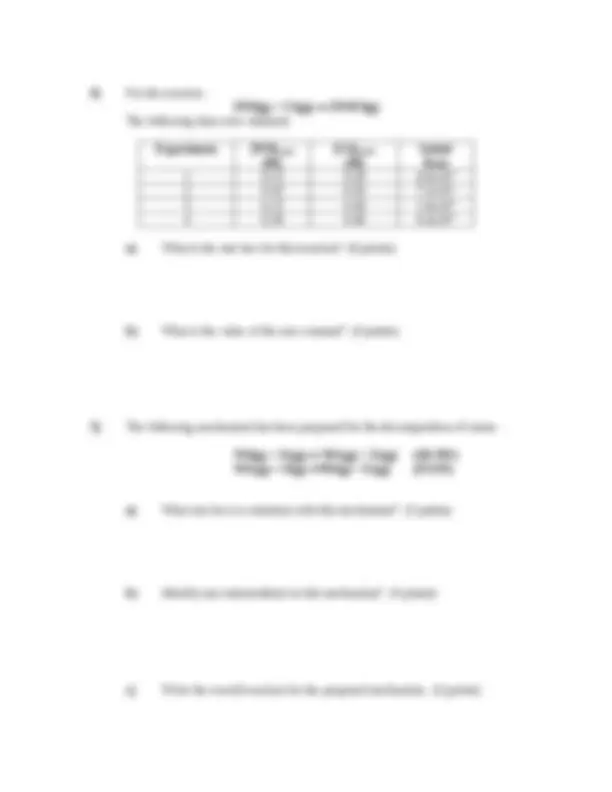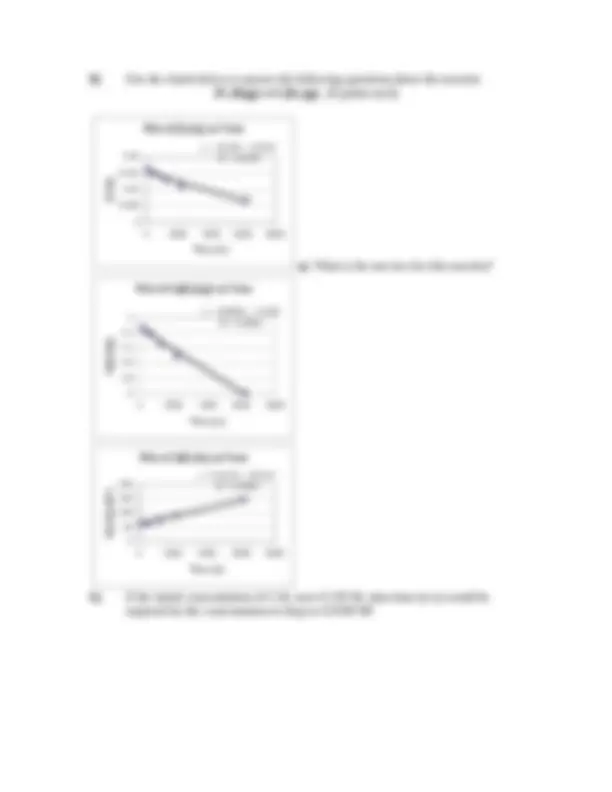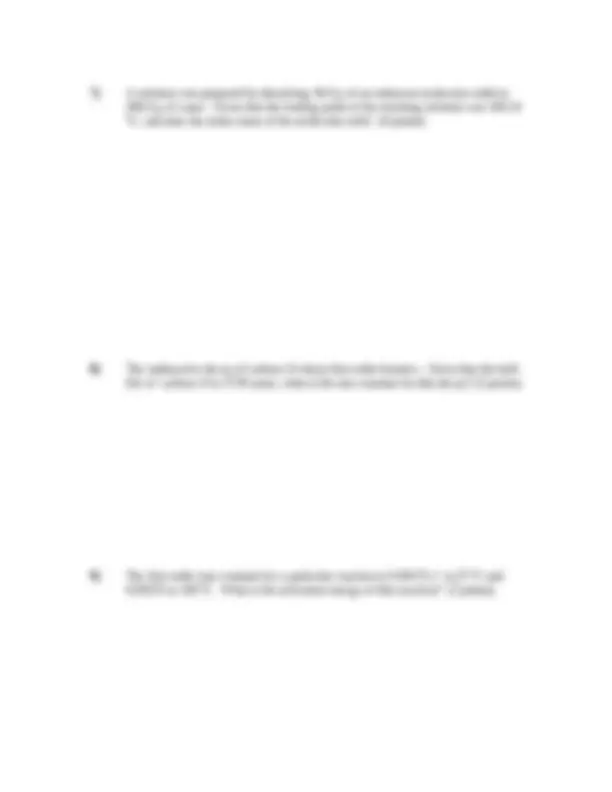





Study with the several resources on Docsity

Earn points by helping other students or get them with a premium plan


Prepare for your exams
Study with the several resources on Docsity

Earn points to download
Earn points by helping other students or get them with a premium plan
Community
Ask the community for help and clear up your study doubts
Discover the best universities in your country according to Docsity users
Free resources
Download our free guides on studying techniques, anxiety management strategies, and thesis advice from Docsity tutors
A chemistry exam from spring 2000, consisting of multiple-choice questions and problems related to topics such as rate constants, solubility, henry's law, rate laws, reaction mechanisms, and more. Students are required to identify terms, answer questions about solutions, calculate henry's law constants, determine rate laws and rate constants, identify intermediates, and use provided data to answer questions.
Typology: Exams
1 / 6

This page cannot be seen from the preview
Don't miss anything!




Spring 2000 1) Match the term in column A to the one term or statement in column B that best describes it. Notice that there will be four definitions from column B that will not be used. (1 point each)
Rate Constant 1) The proportionality constant in the relationship between reaction rate and reactant concentrations. Solubility 2) The exponent, determined by experiment, of the reactant concentration in a rate law. Molality 3) A substance that speeds up a reaction without being consumed. Order 4) The slowest step in a reaction mechanism. LeChatelier’s Principle 5) A system at equilibrium, or striving to attain equilibrium, responds in such a way as to counteract any stress placed upon it. Catalyst 6) The threshold energy that must be overcome to produce a chemical reaction. Intermediate 7) The time required for a reactant to reach half of its initial concentration. Rate-Determining Step 8) A substance that has the ability to emulsify and wash away oil and grease in as aqueous suspension. Half-Life 9) A species that is neither a reactant nor a product but that is formed then consumed in the reaction sequence. Activation Energy 10) The amount of a substance that dissolves in a given volume of solvent. 11) The moles of solute divided by the kilograms of solvent. 12) The rate constant divided by two. 13) The constant for the equilibrium expression representing the dissolving of an ionic solid in water. 14) The energy change when one mole of formula units of a crystalline solid is formed from its ions, atoms, or molecules in the gas phase.
2) A solution contains 11.10 g of eugenol (C 10 H 12 O 2 ) in 600.0 g of benzene (C 6 H 6 ). Answer the following questions about this solution at 25.0 0 C. (4 points each) a) What is the molality of this solution? b) What is the vapor pressure of the solution? c) What is the freezing point of the solution? d) What is the boiling point of the solution? 3) Given that the solubility of CO 2 in water is 1.12 x 10-3^ M when the partial pressure of CO 2 is 25 mmHg, calculate the Henry’s Law constant for CO 2. (5 points)
6) Use the charts below to answer the following questions about the reaction 2C 4 H 6 (g) C 8 H 12 (g). (6 points each) Plot of [C 4 H 6 ] vs Time y = -1E-06x + 0. R^2 = 0. 0
0 2000 4000 6000 8000 Tim e (s) [C H 4 ] 6 a) What is the rate law for this reaction? Plot of ln([C 4 H 6 ]) vs Time y = -0.0001x - 4. R^2 = 0.
-4. -4. -4. -4.
0 2000 4000 6000 8000 Tim e (s) ln([C H 4 ]) 6 Plot of 1/[C 4 H 6 ] vs Time y = 0.0142x + 59. R^2 = 0. 0 50 100 150 200 0 2000 4000 6000 8000 Tim e (s) 1/[C H 4 ] (M 6 -1) b) If the initial concentration of C 4 H 6 were 0.150 M, what time (in s) would be required for the concentration to drop to 0.0100 M?
7) A solution was prepared by dissolving 36.0 g of an unknown molecular solid in 300.0 g of water. Given that the boiling point of the resulting solution was 100. (^0) C, calculate the molar mass of the molecular solid. (6 points) 8) The radioactive decay of carbon-14 obeys first order kinetics. Given that the half- life of carbon-14 is 5730 years, what is the rate constant for this decay? (5 points) 9) The first order rate constant for a particular reaction is 0.00155 s-1^ at 25 0 C and 0.00255 at 100 0 C. What is the activation energy of this reaction? (5 points)